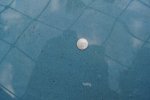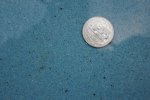Does this look like black algae? I have treated it twice in 3 weeks, but it contines to grow/appear. The largest spot is about half the size of a pencil eraser and they are not growing any bigger; most are much smaller. It only grows/appears on the bottom and curved part of the wall, never on the wall itself. I have scrubbed with a steel brush and chlorine tab, then treated with Black Algae Killer from Leslies, twice. My water chemistry has held constant for the past few months, during the time that it started to appear. A test from today is below:
FAC 3 ppm
TAC 3
Salt 4,000 ppm
CH 250 ppm
CYA 100 PPM
TA 100 PPM
pH 7.6
Copper 0 ppm
Iron 0ppm
The pool is a 10,000 gal saltwater pool, and is 3 years old. I have never had any issue with it until this problem has been creeping up. In the pictures, the small dark (almost black) spots are the 'algae' that I am referring to. There is a bit of mottling in the picture, but the dark spots on the curved part of the wall is what is growing/spreading.
Thanks in advance,
Zach
FAC 3 ppm
TAC 3
Salt 4,000 ppm
CH 250 ppm
CYA 100 PPM
TA 100 PPM
pH 7.6
Copper 0 ppm
Iron 0ppm
The pool is a 10,000 gal saltwater pool, and is 3 years old. I have never had any issue with it until this problem has been creeping up. In the pictures, the small dark (almost black) spots are the 'algae' that I am referring to. There is a bit of mottling in the picture, but the dark spots on the curved part of the wall is what is growing/spreading.
Thanks in advance,
Zach




